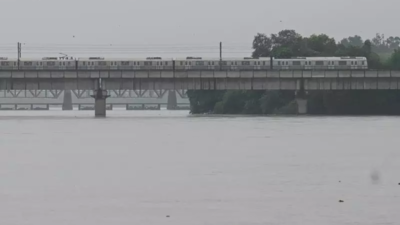NEW DELHI: The monsoon imparts a degree of health to the Yamuna. This year’s excess rainfall in July and Aug have flushed the river of pollutants and improved the flow. Delhi Pollution Control Committee’s monthly analysis shows water quality this season is far better than in earlier months, even better than Aug last year. But the vexing question is how the capital can keep its river clean year-round. The rain-caused relief is temporary. Despite the increased flow, contaminants in the river water are above permissible limits, with fecal coliform at an unimaginable count. The city’s major drains, among them the Najafgarh and Shahdara channels, continue to disgorge untreated or partially treated sewage, undoing much of the monsoon’s cleansing effect. The question is not whether the Yamuna can recover. It clearly can as July-Aug have shown. The real concern is how Delhi can sustain this improved river health throughout the seasons. Experts reiterated that the solution was in ensuring copious flow in the river alongside upgrading and maintaining of sewage treatment infrastructure. As Bhim Singh Rawat, associate coordinator, South Asia Network on Dams, Rivers and People, pointed out, despite pumping crores of rupees into sewage treatment and common effluent treatment plants, their performance was questionable. “During the rains, the Yamuna regains its hydrological functions, gets back its free-flowing status and rejuvenates the floodplain biota. But within a month or two afterwards, the pollution surges back and turns the river into a stinking drain,” sighed Rawat. “In order to maintain and further improve the river health restored by floods, the govts of the Yamuna basin states, mainly Haryana and Delhi, must work out a multipronged approach to increase environmental flows and reduce effluents discharge into the river stretches under their jurisdiction.” Earlier this month, a special committee established by Delhi High Court identified numerous irregularities in the functioning of STPs after inspecting the 37 facilities. It flagged substandard treatment processes, insufficient monitoring, mixing of industrial and domestic sewage and bypassing of sewage without treatment. The report also claimed treated sewage from some plants was being dumped into untreated channels, like Shahdara drain. Such an impact was evident in Aug, where despite improvement in water quality, substantial damage is indicated downstream of Wazirabad after the Najafgarh drain empties into the Yamuna. Fecal coliform, signifier of untreated sewage, was 640 MPN/100ml at Wazirabad, much lower than the acceptable standard of 2,500. But at ISBT bridge, the measurement rose 34 times to 22,000 units. That too was an improvement because in July, the figure of 3,900 at Wazirabad had spiked to a whopping 28,00,000 units at ISBT.

According to the Centre for Science and Environment, only around 300km of the Yamuna’s 1,376km course is pristine, predominantly in Uttarakhand. Around 80% of the sources that pollute the rest of its course originate in Delhi, where the largest polluter is the Najafgarh drain. With several other drains, the large ones being Shahdara, Tughlaqabad and Sahibabad, also emptying into the river, the Yamuna is steeped in sewage by the time it enters UP. A 2014 study by Delhi University professor Shashank Gupta, Jamia Millia Islamia’s Vikram Soni and Natural Heritage First’s Diwan Singh determined that 50-60% of the virgin flow is necessary throughout the year to maintain the Yamuna’s river system. In Delhi, the river needed a minimum freshwater flow of 6.6 million cubic metres/day to prevent algal choking. The Yamuna’s current natural flow is less than 0.86 MCM/day at Palla, while downstream of Wazirabad, the freshwater flow is nil, with the river receiving drain contents. The sewage, both treated and untreated, was assessed at 3.27MCM/day in 2014. The actual river flow remains unassessed.











